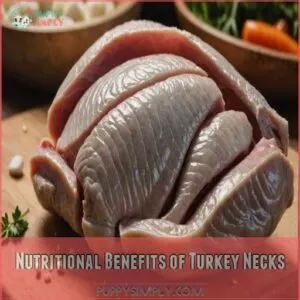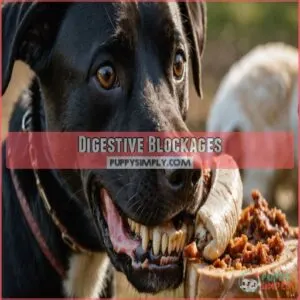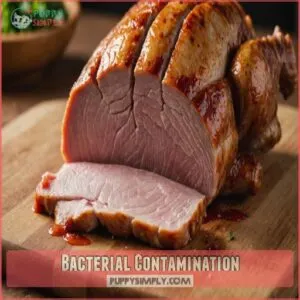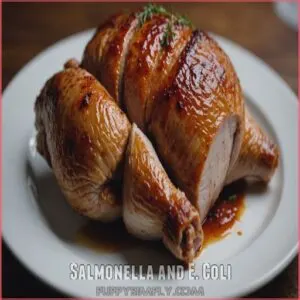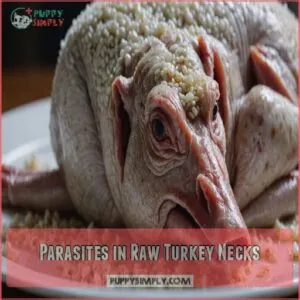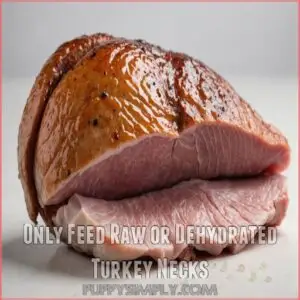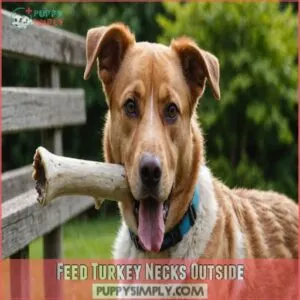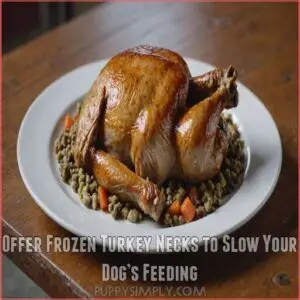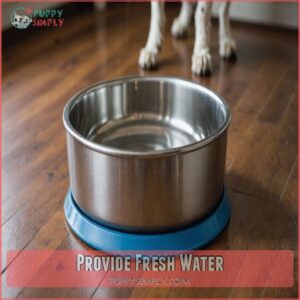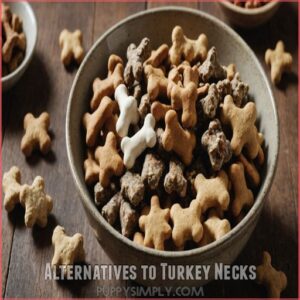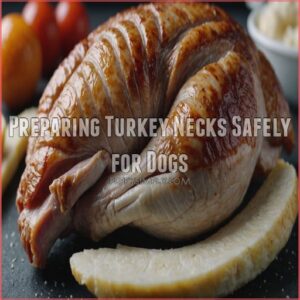This site is supported by our readers. We may earn a commission, at no cost to you, if you purchase through links.
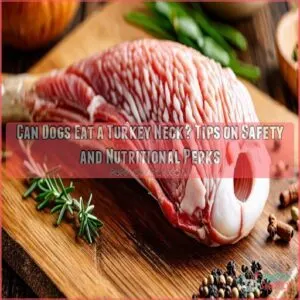 You can safely feed your dog turkey necks, but there’s a key catch: they must be raw or dehydrated, never cooked.
You can safely feed your dog turkey necks, but there’s a key catch: they must be raw or dehydrated, never cooked.
While these protein-packed treats offer amazing benefits for your pup’s teeth and joints, cooked turkey necks can splinter and cause serious internal injuries.
Raw turkey necks provide natural dental cleaning and essential nutrients like calcium and glucosamine.
Just remember to supervise your furry friend during chew time, and start with small portions to see how they handle it.
Many pet parents don’t realize there’s actually a right way to serve turkey necks that maximizes benefits while keeping their dogs safe.
Table Of Contents
- Key Takeaways
- Nutritional Benefits of Turkey Necks
- Safety and Precautions
- Feeding Turkey Necks to Dogs
- Alternatives to Turkey Necks
- Preparing Turkey Necks Safely for Dogs
- Veterinary Opinions and Recommendations
- Frequently Asked Questions (FAQs)
- Can a dog eat a cooked turkey neck?
- Can dogs get salmonella from raw turkey neck?
- Can dogs eat neck bone meat?
- Is turkey neck safe to eat?
- Are turkey necks suitable for puppies and seniors?
- How often should dogs eat turkey necks?
- Can dogs eat store-bought versus wild turkey necks?
- Do turkey necks cause digestive problems or constipation?
- Should turkey necks be served frozen or thawed?
- Conclusion
Key Takeaways
- You should only feed your dog raw or dehydrated turkey necks, as raw bones provide valuable nutrients, including calcium and phosphorus, especially when given in safe bone portions, never cooked ones, as cooked bones can splinter and cause internal injuries.
- You’ll get multiple health benefits from turkey necks – they’re rich in protein, calcium, and joint-supporting glucosamine, while helping clean your dog’s teeth naturally.
- You can reduce health risks by feeding turkey necks outside, cutting them into smaller pieces, and always providing fresh water nearby while your dog eats.
- You shouldn’t give turkey necks to all dogs – they’re not recommended for puppies under 6 months, senior dogs with dental issues, or breeds prone to gulping food.
Nutritional Benefits of Turkey Necks
For turkey necks, your dog gets a tasty snack that’s packed with protein and important nutrients like calcium, glucosamine, and chondroitin.
These treats are also low in calories and fat, making them a healthier option for your furry friend who can’t resist their crunchy goodness.
High Protein Content
For adding muscle mass or managing weight, turkey necks can be a rich source of lean protein.
They’re particularly beneficial for growing puppies and senior dogs.
Here’s why you might consider them:
- Muscle building: Supports healthy growth.
- Weight management: Low-fat option.
- Protein for puppies: Promotes development.
These turkey necks are a real treat!
Calcium for Bone Health
So, you’ve learned about the protein power in turkey necks.
Now, let’s talk calcium! Strong bones are a must for your furry friend. Turkey necks are a good source of calcium, supporting bone development and healthy bones.
Check out this handy chart:
| Age (Years) | Daily Calcium Needs (mg) | Turkey Neck Calcium Content (mg/neck) | Bone Density Improvement | Potential Calcium Deficiency Symptoms |
|---|---|---|---|---|
| 1 | 500 | 100-200 | Improved bone growth | Lethargy, muscle weakness |
| 3 | 700 | 150-300 | Increased bone strength | Joint pain, stiffness |
| 5 | 800 | 200-400 | Maintained bone mass | Fractures |
| 7 | 900 | 250-500 | Slowed bone loss | Loss of appetite |
| 10 | 1000 | 300-600 | Reduced risk of osteoporosis | Dental issues |
Remember, a balanced diet is key, but turkey necks can be a tasty addition to your dog’s routine.
Glucosamine and Chondroitin for Joints
If your dog seems stiff after a fetch session, turkey necks might be just the ticket.
Packed with glucosamine and chondroitin, they support joint health and help fend off arthritis, providing a bioavailable form of glucosamine and chondroitin.
Natural remedy for canine arthritis.
While they’re not a one-stop shop for all joint issues, these natural supplement options provide benefits without typical side effects.
Remember, always check dosage recommendations with your vet.
Low in Calories and Fat
Your pup’s joints benefit from glucosamine, and turkey necks also bring low calories and fat into their diet.
You can find a variety of turkey neck products suitable for your dog online at dog turkey neck options.
It’s the perfect combo for weight management.
Delicious and healthy, these lean protein treats are exactly what you need to keep your dog in shape.
Think of turkey necks as nature’s tasty way for a balanced dog diet without compromising flavor.
Safety and Precautions
When sharing turkey necks with your dog, safety should be your top priority, as these treats can pose risks like choking or digestive blockages.
By understanding the potential dangers, such as bacterial contamination and parasites, you’ll keep your furry friend safe and healthy without sacrificing their enjoyment.
Choking Hazard
After learning about turkey necks’ protein boost, let’s talk about safety. Choking hazards lurk within those bones. Watch for signs of choking to make sure your dog’s safe swallowing.
- Choking risks: Monitor your pet closely.
- Bone content: Use precaution with sharp fragments.
- Choking prevention: Offer appropriately sized pieces.
- Choking first aid: Know the basics for emergencies.
Digestive Blockages
Concerns about choking hazards often lead to questions about digestive blockages.
Offering a turkey neck without understanding safe chew size can cause bone content to lodge in your pup’s system.
Watch for signs of blockage like vomiting and constipation.
Prevention tips include ensuring chew pieces are appropriate.
Ignoring this could lead to esophageal foreign bodies and possibly surgery, impacting your dog’s digestion.
Bacterial Contamination
Bacterial contamination is a real concern with raw turkey necks. Here’s how you can reduce the risks:
- Safe Handling: Wash your hands and surfaces thoroughly.
- Cooking Turkey Necks: Makes sure pathogens in raw meat are destroyed.
- Storage: Keep raw turkey necks separate from other foods.
- Dog’s Immune System: Monitor dog health for signs of trouble.
Salmonella and E. Coli
Raw turkey necks carry risks, like E. coli and salmonella, nasty bacteria found in raw meat.
Consuming spoiled meat, including raw poultry, can lead to food poisoning dangers.
These pathogens can make your dog seriously ill.
Proper cooking is key to eliminating these dangers.
Think of it like this: you wouldn’t eat raw chicken, right? Same goes for your pup!
Always cook turkey necks thoroughly to guarantee your dog’s safety.
Following raw turkey neck safety guidelines protects your furry friend.
Parasites in Raw Turkey Necks
After considering risks like Salmonella, you should also be aware of parasites in raw turkey necks.
It might sound like a horror show, but parasite prevention is manageable.
Here’s how:
- Identify parasites lurking in raw turkey necks.
- Cook thoroughly to eliminate them.
- Handle safely to avoid cross-contamination.
- Monitor dog’s health for sudden issues.
Feeding Turkey Necks to Dogs
When feeding turkey necks to your dog, it’s essential to stick with raw or dehydrated options to maximize safety and nutrition.
Consider offering them outside or frozen, make sure they’ve fresh water, and maybe even hand-feed if your furry friend tends to gulp down treats faster than a speeding car.
Only Feed Raw or Dehydrated Turkey Necks
When weighing safety concerns, consider feeding your dog raw or dehydrated turkey necks.
Cooking makes bones brittle, not ideal for chomping canines.
Raw turkey neck dogs enjoy benefits like better dog teeth and digestion.
Dehydrated necks turn into nutritious dog treats.
Here’s a quick look:
| Type | Benefits | Concerns |
|---|---|---|
| Raw | Teeth cleaning, digestion | Parasites, contamination |
| Dehydrated | Safe treats, long-lasting | Loss of some nutrients |
| Cooked | Soft texture | Brittle bones, choking |
Feed Turkey Necks Outside
Feeding turkey necks outside is a great way to maintain outdoor feeding hygiene. You’ll prevent mess indoors and minimize bacterial contamination.
When preparing turkey necks, consider cutting them into small pieces to prevent choking hazards, as turkey neck safety.
Enjoy the peace of mind knowing your home stays clean while your pup munches away. Just keep an eye out for wildlife and clean up afterward.
Consider these aspects:
- Outdoor feeding hygiene
- Preventing mess
- Attracting wildlife
- Yard cleanup
- Safety from predators
Feed by Hand if You Have a Gulper
Got a gulper on your hands? No sweat! Hand-feeding turkey necks can be a game-changer for those enthusiastic eaters.
It’s like being your pup’s personal chef, controlling the pace and size of each bite. This method helps prevent choking and makes sure your furry friend savors every morsel.
Check out these hand-feeding techniques:
| Technique | Benefit |
|---|---|
| Break into chunks | Easier swallowing |
| Hold firmly | Slows eating pace |
| Offer one piece at a time | Prevents overeating |
Remember, patience is key when hand-feeding your gulper!
Offer Frozen Turkey Necks to Slow Your Dog’s Feeding
Is your pup a speed-eater?
Try offering frozen turkey necks!
This nifty trick slows down even the most enthusiastic chow hounds.
Freezing turkey necks extends chewing time, giving your dog’s digestion a helping hand.
For high-quality options, you can find frozen turkey necks online, such as buy frozen turkey necks.
It’s like nature’s slow feeder!
Plus, it’s a mess-control win: less slobber, more enjoyment.
Just remember, moderation is key.
Frozen turkey necks can be a tasty, teeth-cleaning treat that keeps your furry friend busy and satisfied.
Provide Fresh Water
While your dog’s chomping on a turkey neck, keep fresh water within paw’s reach.
You’ll want to use a generously sized water bowl to quench their thirst after all that gnawing.
Refill it frequently with clean, room-temperature water to support digestion and prevent choking.
Remember, proper hydration is key when your pup’s enjoying these protein-packed treats.
It’s a simple step that’ll keep your furry friend safe and satisfied.
Alternatives to Turkey Necks
If you’re looking for safe alternatives to turkey necks for your furry friend, you’ve got plenty of options.
From cooked chicken or beef necks to dental chews, frozen fruits, and even the occasional dab of peanut butter, there are many tasty and nutritious treats that’ll have your pup’s tail wagging.
Cooked Chicken or Beef Necks
Looking for alternatives to turkey necks?
Cooked chicken or beef necks can be a tasty treat for your pup.
They’re packed with protein and minerals, just like their turkey cousins.
But remember, cooking is key!
It kills harmful bacteria and makes the bones softer, reducing choking risks.
Cut them into bite-sized pieces and watch your furry friend enjoy.
As always, moderation is the name of the game!
Dental Chews or Toys
Dental chews and toys offer a safer alternative to turkey necks for your pup’s chompers.
These specialized treats come in various shapes and sizes, designed to scrape away plaque and massage gums.
From rawhide-free options to rubber toys, you’ll find something that suits your dog’s chewing style.
Just remember to choose the right size and supervise playtime to prevent choking hazards.
It’s like giving your furry friend a toothbrush they’ll actually enjoy using!
Frozen Fruits and Vegetables
Frozen fruit-and-veggie treats can be a cool alternative to turkey necks for your pup.
They’re like nature’s popsicles, offering a pleasant crunch and nutritional boost.
But remember, not all fruits and veggies are dog-friendly.
Here are some safe options:
- Frozen banana slices
- Carrot coins
- Blueberry cubes
Always thaw slightly before serving to prevent tooth damage.
These icy snacks can help soothe teething pups or keep your dog entertained on hot days.
Just keep portions small to avoid tummy troubles.
Commercial Dog Treats
Your pup’s treat jar doesn’t have to be a turkey neck-only zone.
There’s a smorgasbord of commercial dog treats that’ll make tails wag.
From crunchy biscuits to chewy jerky, you’ll find options packed with protein and flavor.
Look for treats with natural ingredients, no artificial preservatives, and appropriate sizes for your dog’s breed.
Remember, moderation is key – treats should make up no more than 10% of your furry friend’s daily calorie intake.
Peanut Butter or Cheese in Moderation
Looking for tasty alternatives to turkey necks?
Peanut butter and cheese can be fantastic treats for your pup, but moderation is key.
A small dollop of unsalted peanut butter or a tiny cube of low-fat cheese can make your dog’s tail wag.
Just remember, these high-calorie goodies should be occasional indulgences.
Keep an eye out for allergies, especially with peanut butter.
Stick to a treat frequency that fits your dog’s diet plan, and you’ll have one happy, healthy pooch!
Preparing Turkey Necks Safely for Dogs
You’ve decided to treat your pup to a turkey neck, but hold your horses—there’s a right way to do it.
When considering adding turkey necks to your dog’s diet, it’s essential to weigh the benefits, such as cleaning teeth with raw turkey necks, against potential risks. Let’s walk through the steps to prepare turkey necks safely for your furry friend, ensuring they can enjoy this tasty treat without any unwanted surprises.
Removing Excess Fat and Skin
While alternatives can be tempting, preparing turkey necks safely is key.
Start by trimming excess fat and removing the skin, much like how you’d prepare for a survival situation by utilizing pine resin for various uses.
This step’s a game-changer for your pup’s health.
Too much fat can lead to pancreatitis, while the skin’s a choking hazard.
Think of it as giving your furry friend a lean, mean protein machine.
Your dog will still love the taste, minus the extra calories and risks.
Cutting Into Small Pieces
When choosing turkey necks as a treat, consider the risks associated with splintered bones causing intestinal damage. Size is important when it comes to turkey neck dog treats.
Chopping them into smaller pieces is essential for your pup’s safety.
Here’s why it’s important:
- Prevents choking hazards
- Easier for dogs to chew and digest
- Allows better portion control
- Reduces the risk of intestinal blockages
By cutting turkey necks into bite-sized chunks, you’re not just preventing choking – you’re also making mealtime more manageable and enjoyable for your furry friend.
Remember, a little extra prep goes a long way in keeping your dog safe and satisfied.
Cooking Thoroughly
Proper cooking is essential for safe consumption, as raw turkey necks can be contaminated with bacteria like Salmonella and E. coli, so your next step for safe turkey neck dog treats.
You’ll want to reach an internal temperature of 165°F to kill harmful bacteria.
Boil the pieces for about 20-25 minutes, or bake them at 350°F for 30-35 minutes.
Don’t microwave – it creates hot spots that could harm your pup.
A meat thermometer‘s your best friend here to make sure you cook the treats evenly and prevent foodborne illness.
Supervising Dogs While Eating
Keeping an eye on your dog during turkey neck time isn’t just about being a helicopter parent – it’s about smart pet care.
You’ll want to watch them like a hawk to prevent any mishaps and make sure their digestion is safe.
- Stay within arm’s reach during feeding sessions
- Monitor their chewing patterns and speed
- Look for signs of difficulty or distress
- Remove distractions from other pets
- Keep fresh water nearby
These watchful moments strengthen your bond and keep your furry friend safe.
Discarding Uneaten Portions
Once you’ve watched your pup enjoy their turkey neck, don’t let leftovers become tomorrow’s trouble.
You’ll want to toss any uneaten portions after two hours at room temperature – bacteria don’t take vacations!
Here’s your quick guide to handling those remnants safely:
| Time Frame | Storage Method | Action Required |
|---|---|---|
| 2 hours | Room temp | Discard immediately |
| 24 hours | Refrigerated | Use or freeze |
| 3 months | Frozen | Safe to keep |
| > 3 months | Any | Time to toss |
Veterinary Opinions and Recommendations
You’ll want to hear what veterinarians have to say about feeding turkey necks to your furry friend, as their expert insights can help you make the safest choice for your dog’s unique needs.
While some vets give turkey necks the thumbs up as occasional treats, others recommend caution due to potential risks like choking or bacterial contamination, especially for certain breeds and ages.
Safe in Moderation as Treats
Most veterinarians agree you can safely give your dog turkey necks as occasional treats, but they shouldn’t make up more than 10% of your pup’s daily calories.
For medium-sized dogs, that’s about one turkey neck per week.
You’ll want to introduce these treats gradually and monitor how your dog handles them.
Raw turkey necks can be particularly beneficial for dental health.
Not Recommended for Certain Dogs
Despite their nutritional benefits, turkey necks aren’t safe for all our furry friends.
You’ll want to skip them if you’ve got puppies, seniors, or small breeds who might struggle with the size.
Dogs with digestive issues, pregnant pups, or those prone to constipation should also pass.
Like people, some dogs have food allergies, so watch for signs of sensitivity when introducing new treats.
Advising Against Raw Turkey Necks
Veterinarians increasingly warn against feeding raw turkey necks to dogs due to bacterial risks and potential bone fragments.
While certain dogs can’t handle turkey necks at all, raw options pose dangers for every pup.
Bacteria like salmonella can make both you and your furry friend sick.
You’ll want to think about safer alternatives, such as specially designed dental chews or cooked meat treats.
Consulting a Vet Before Diet Changes
Before adding turkey necks to your pup’s menu, let’s have a chat with your vet about your dog’s unique health needs. You’ll want professional guidance to make sure it’s a safe choice for your furry friend.
- Your vet can check for medication interactions that might affect digestion
- They’ll review your dog’s health conditions and dietary restrictions
- You’ll get personalized feeding frequency recommendations based on your dog’s size and activity level
Alternative Treat Options
Now that you’ve got the green light from your vet, you’ll love these tail-wagging alternatives!
Try making homemade dog treats with natural ingredients like sweet potato chips or frozen yogurt bites.
DIY chew toys, like braided rope toys or stuffed Kongs, can keep your pup busy.
For budget-friendly options, carrots and apple slices make fantastic safe snacks that support dog enrichment and healthy digestion.
Frequently Asked Questions (FAQs)
Can a dog eat a cooked turkey neck?
Like a ticking time bomb, cooked turkey necks can splinter and harm your dog’s digestive system.
You’ll want to avoid feeding these entirely.
Raw turkey necks are a safer choice for your pup.
Can dogs get salmonella from raw turkey neck?
Your dog can contract salmonella from raw turkey necks, though their robust digestive system often handles it well.
You’ll still want to handle raw meat carefully and monitor for signs of illness.
Can dogs eat neck bone meat?
Craving answers about feeding your furry friend?
You’ll be glad to know dogs can safely eat neck bone meat when it’s best to avoid cooked turkey neck bones risks, but raw or cooked, neck bone meat is safe when you supervise and remove small bones.
Is turkey neck safe to eat?
Raw turkey necks can be safe to eat when properly cooked above 165°F.
They’re packed with nutrients and protein, but you’ll want to remove small bones to prevent choking hazards.
Monitor consumption carefully.
Are turkey necks suitable for puppies and seniors?
For puppies, wait until they’re 6 months old before offering turkey necks. Senior dogs can enjoy them too, but you’ll want to monitor their chewing ability and dental health for safety.
How often should dogs eat turkey necks?
Picture your pup’s tail wagging with excitement!
You’ll want to serve turkey necks just 1-2 times weekly as treats.
They’re perfect for dental health, but moderation’s key to maintain a balanced diet.
Can dogs eat store-bought versus wild turkey necks?
You can safely feed your dog both store-bought and wild turkey necks, but it’s essential to note that unlike cooked bones’ dangers, raw turkey necks are generally safe, store-bought options tend to be cleaner and more regulated.
Wild turkey necks might carry parasites, so proper cleaning’s essential.
Do turkey necks cause digestive problems or constipation?
Properly prepared poultry necks won’t cause problems if fed correctly.
Raw turkey necks are easily digestible and won’t lead to constipation.
Monitor your pup’s portions and pair with plenty of water for safe snacking.
Should turkey necks be served frozen or thawed?
Serve turkey necks thawed for adult dogs and frozen for teething puppies.
Raw necks should be completely defrosted in the refrigerator to prevent choking hazards and make sure safe, enjoyable chewing sessions.
Conclusion
Picture your pup’s tail wagging with joy as they savor a raw turkey neck – it’s a safe, nutritious treat when served correctly.
Remember, the key to feeding turkey necks to your dog lies in proper preparation and supervision.
Whether you choose raw, dehydrated, or safer alternatives, always prioritize your dog’s safety and consult your vet before making dietary changes.
By following these guidelines, you can confidently offer turkey necks as part of a balanced diet that keeps your furry friend healthy and happy.

